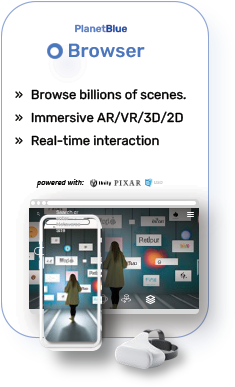The Components of The Spatial Web
There are four high-level components to the Spatial Web.
-
The PlanetBlue Browser
-
The markup language
-
The scene server
-
And the Spatial Container

The Spatial Browser works in a similar way to a web browser but with greatly expanded functionality.
Like a web browser there’s only one browser needed for visiting any of the billions of spatial scenes possible.
The browser is written in Unity, which means it can behave in a very similar way to an online game. It enables fly-over and immersive rendering of scenes. It supports MR, VR, 3-D, and 2-D and the upcoming Apple Spatial headset experiences.

The spatial markup language (SPML) is used to defines the scene and the objects in the scene. Elements in the scene may be .obj, .usd and native SPML surfaces.

Like a web server, the scene server runs on existing Web servers or may be hosted in the cloud. It’s a serverless model which allows for massive scalability and billions of instances.

The Spatial Container is the atomic unit of the Spatial Web. It contains multiple layers which define the components of a digital twin, an object or a scene. It’s been designed with First Principles thinking and stored in JSON.
The container is recursive and horizontally linked so there’s an unlimited number of containers possible. It's sparse, so only the needed components exist for each object.
You can think of it as web pages, databases, blockchain, programs, AI behaviors, 3D objects, USD scenes, all blended into a simple and elegant JSON array.
The Spatial Container is what makes the entire world work seamlessly. It’s a huge step forward in simplicity of design.